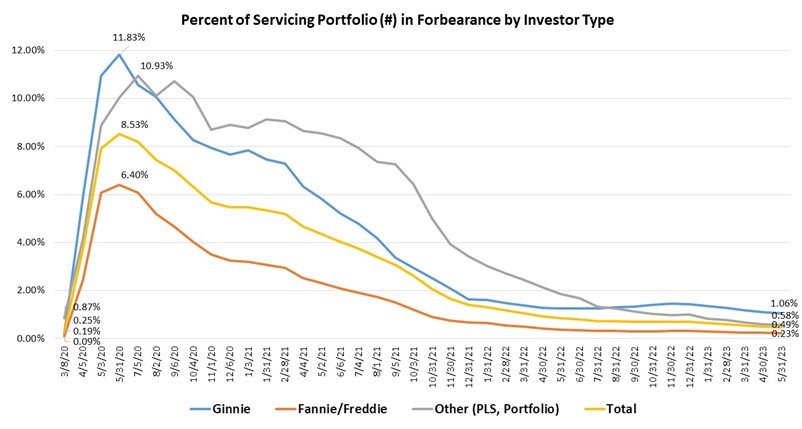 The Mortgage Bankers Association (MBA) latest Loan Monitoring Survey for the month of May 2023 revealed that the total number of loans now in forbearance decreased by two basis points from 0.51% of servicers’ portfolio volume in the prior month to 0.49% as of May 31, 2023.
The Mortgage Bankers Association (MBA) latest Loan Monitoring Survey for the month of May 2023 revealed that the total number of loans now in forbearance decreased by two basis points from 0.51% of servicers’ portfolio volume in the prior month to 0.49% as of May 31, 2023.
The MBA estimates that 245,000 homeowners are in forbearance plans, and that servicers have provided forbearance opportunities to approximately 7.9 million borrowers since March 2020.
By loan type, the share of Fannie Mae and Freddie Mac (GSE) loans in forbearance decreased one basis point from 0.24% to 0.23%, while Ginnie Mae loans in forbearance decreased five basis points from 1.11% to 1.06%. The forbearance share for portfolio loans and private-label securities (PLS) decreased three basis points from 0.61% to 0.58%.
“The number of loans in forbearance is reaching levels not seen since the beginning of March 2020, prior to the passage of the CARES Act,” said Marina B. Walsh, CMB, MBA’s VP of Industry Analysis. “Today, more than 96% of homeowners are current on their mortgages, thanks to the favorable jobs market and the success of loss mitigation options over the past three years.”

By stage, 34.9% of total loans in forbearance were in the initial forbearance plan stage, while 52.6% were in a forbearance extension. The remaining 12.5% represented forbearance re-entries, including re-entries with extensions. Total loans serviced that were current (not delinquent or in foreclosure) as a percentage of servicing portfolio volume increased to 96.12% in May 2023 from 95.89% in April 2023 (on a non-seasonally adjusted basis).
Total completed loan workouts from 2020 and onward (repayment plans, loan deferrals/partial claims, loan modifications) that were current as a percent of total completed workouts increased to 74.93% in May from 74.39% month-over-month.
Of the cumulative forbearance exits for the period from June 1, 2020, through May 31, 2023, at the time of forbearance exit:
- 29.6% resulted in a loan deferral/partial claim.
- 17.9% represented borrowers who continued to make their monthly payments during their forbearance period.
- 17.8% represented borrowers who did not make all of their monthly payments and exited forbearance without a loss mitigation plan in place yet.
- 16.1% resulted in a loan modification or trial loan modification.
- 10.8% resulted in reinstatements, in which past-due amounts are paid back when exiting forbearance.
- 6.6% resulted in loans paid off through either a refinance or by selling the home.
- The remaining 1.2% resulted in repayment plans, short sales, deed-in-lieus or other reasons.
The five states reporting the highest share of loans that were current as a percent of servicing portfolio included:
- Washington
- Idaho
- Colorado
- California
- Oregon
The five states with the lowest share of loans that were current as a percent of servicing portfolio included:
- Louisiana
- Mississippi
- West Virginia
- New York
- Indiana
According the U.S. Department of Labor (DOL), for the week ending June 10, the advance figure for seasonally adjusted initial unemployment claims was 262,000, unchanged from the previous week's revised level. The previous week's level was revised up by 1,000 from 261,000 to 262,000. The four-week moving average was 246,750, an increase of 9,250 from the previous week's revised average—marking the highest level for this average since November 20, 2021, when it was 249,250. The advance seasonally adjusted insured unemployment rate was 1.2% for the week ending June 3, unchanged from the previous week's unrevised rate.

 DSNews The homepage of the servicing industry
DSNews The homepage of the servicing industry









